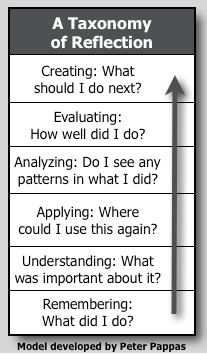Bloom’s (1956) Taxonomy consists of 6 key categories of educational objectives (listed in lower to higher order): Knowledge, Comprehension, Application, Analysis, Synthesis, and Evaluation. Peter Pappas (2010) has used an updated version of Bloom’s Taxonomy (Anderson and Krathwohl’s Taxonomy, 2001) to develop, “A Taxonomy of Reflection“. The categories include: Remembering (recall of a task or concept), Understanding (determining significance), Applying (making connections), Analyzing (finding patterns), Evaluating (assessing strengths and weaknesses) and Creating (future planning). Have a look at the categories, and see how they are similar, but modified. Imagine how you might use Pappas’ taxonomy with your students. Which model do you find is most useful in promoting learning as a process?

Bloom’s Taxonomy (1956), with revisions by Anderson and Krathwohl (2001)

A Taxonomy of Reflection (Pappas, 2010)
The days of teachers directly telling students how they’re doing is becoming outdated. The teaching practice of today is striving to become much more innovative. Paradigms of pedagogy are shifting. There is a greater focus on process and less emphasis on product. Teachers are asking students to gain knowledge, but to also actively think about how they can become better learners and more critical thinkers. Just as teachers are asked to reflect in their own practice, they are to guide their students to become reflective in their learning. Pappas’ model offers explicit questions to help students think actively about their learning. It is yet one further example of how teachers can promote and develop student reflection within the 21st Century classroom.
In my next post, I will include various resources that can be used for student reflections. Do you have any student reflection templates or files that you would like to share?
References:
Armstrong, P. (2018, July 12). Bloom’s Taxonomy. Retrieved August 6, 2018, from https://cft.vanderbilt.edu/guides-sub-pages/blooms-taxonomy/.
Pappas, P. (2012, August 01). The Reflective Student: A Taxonomy of Reflection (Part 2). Retrieved August 6, 2018, from https://peterpappas.com/2010/01/reflective-student-taxonomy-reflection-.html.
Hi Tara,
I think in today’s classrooms, assessments are no longer the end all of a lesson. I do like the change of wording as well from noun (1956) to verb form (2001) as it makes it seem like learning is an active process. With that said, I do find that the updated pyramid still emphasizes memorization as it forms the largest section of the pyramid. I much prefer seeing the flipped pyramid (https://i.pinimg.com/originals/e0/2f/d1/e02fd1ebe408458daf4a25a3de74028a.jpg) instead. What are your thoughts? It notes the importance of ‘create’ and the time that we as educators should be allowing our students. Lots of time should be given to work with and manipulate information and concepts, not merely memorize them.
LikeLiked by 1 person
Hi Ivan. Thanks for commenting! I do like the flipped pyramid! It’s great to have the different perspectives, that’s for certain. Maybe it depends on the task that’s being reflected on? I’m not sure. Does it need to be a pyramid, or could it even just be a rectangle, putting equal emphasis on time allotted for all stages? 🙂 I really like the second pyramid, with “Teach Others” listed. Teaching others is an excellent way to learn more about something, and can be another way to reflect.
Thanks again for your comments and for providing another perspective!
Tara
LikeLike
Hi, Tara!
I really like Pappa’s (2010) Taxonomy of Reflection. The questions remind me of the post-assignment reflections I’ve often included in student work in the past, except for the one about patterns — I’ve never considered that aspect before. Like Ivan, I also appreciate the shift from nouns to verbs. Assessment while or as learning is a huge part of the feedback process.
LikeLiked by 1 person
Thanks for commenting, Victoria. It always seemed a chore for me to fit reflection into my teaching schedule, but after this research, I understand that it is absolutely necessary for the learning process – for teachers and learners. I think I’ll make a poster with Pappa’s “A Taxonomy of Reflection” and have it ready and on-hand in my next classroom. It’s a great resource. Thanks again for your comment!
Tara
LikeLike
Hi Tara,
I really liked how you compared different models for reflection. I agree that there is a shift towards reflecting on the process rather than the product. This is something that I’m trying to emphasize frequently with my students as a way to emphasize their growth and how they can always continue to grow. I really like Pappas’ (2010) Taxonomy of Reflection. It’s a great idea to have it as a poster by the door!
Recently, I used the following list of 40 reflection questions from the 21st-Century Learning Academy in order to create my own reflection for students. I like how they’ve grouped the questions as looking “backward”, “forward”, “inward” or “outward” and I tried to incorporate a mix of different reflection styles for my students. I could also see how you could give these 40 questions to students and request that they choose one from each category to create a response to an assignment or experience.
Here’s the link to the 40 Reflection Questions: https://backend.edutopia.org/sites/default/files/pdfs/stw/edutopia-stw-replicatingPBL-21stCAcad-reflection-questions.pdf
Have you used questions framed like this before? Thanks for an interesting post.
Lisa
LikeLiked by 1 person
Hi Lisa. Thank you for your comment, and thank you for sharing this great list of questions! I have used similar questions, but I sometimes have to rephrase them or give some further explanation, depending on my students’ level of comprehension. Sometimes other students help to explain the questions to any students who have lower English ability. After they’ve answered the questions, they like reading them aloud. Reflection takes time, but it is a valuable teaching practice, both for the students and the teachers!
Thanks again!
Tara
LikeLike